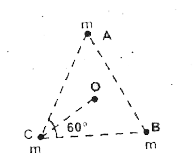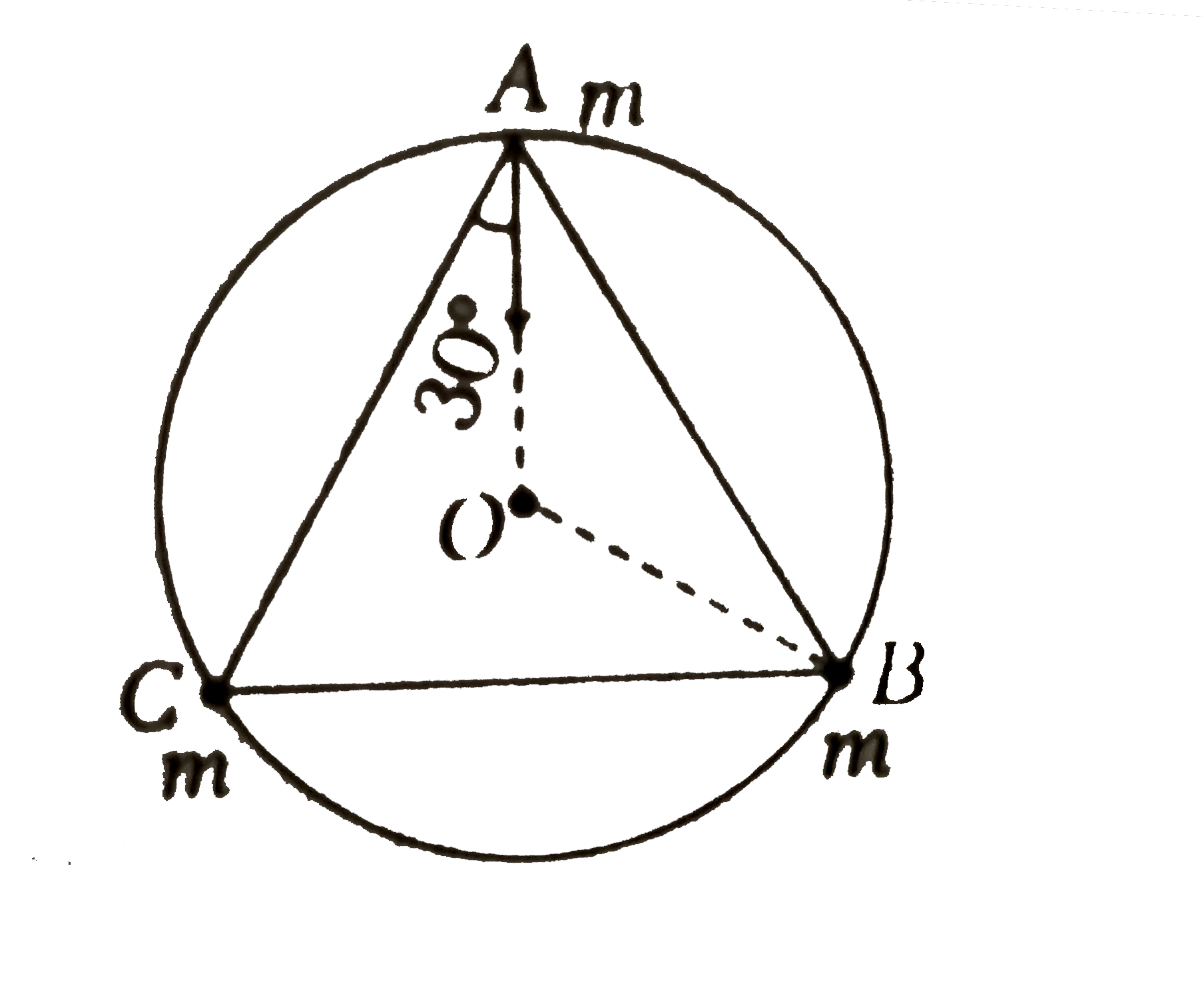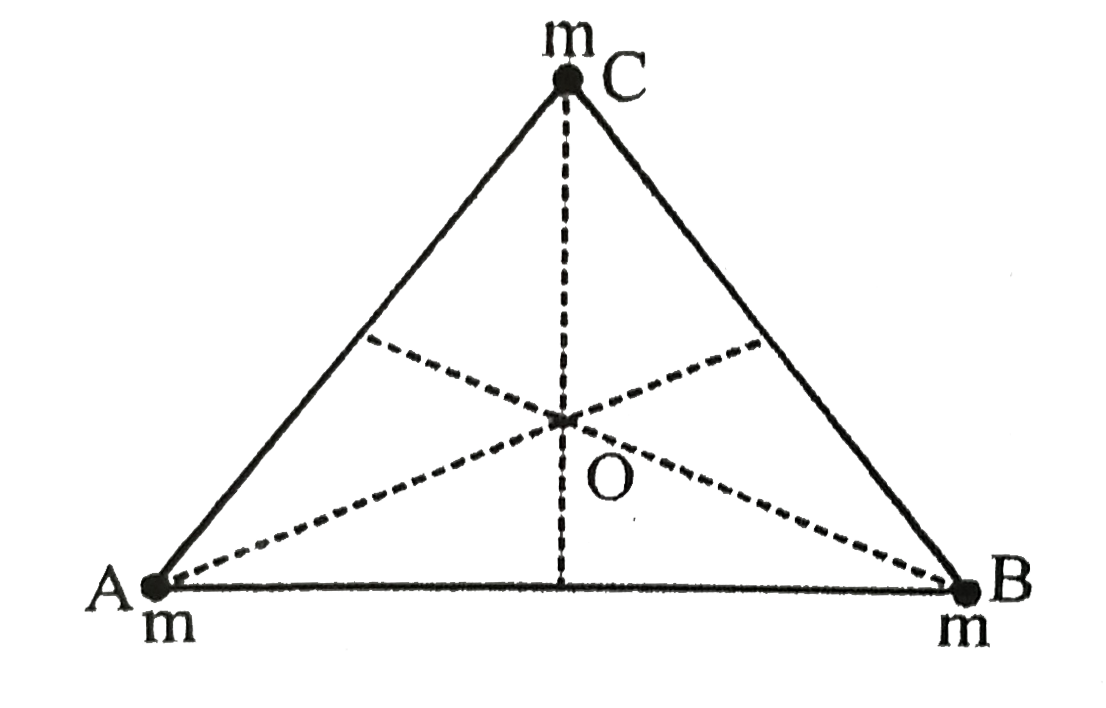Three particles each of mass m are kept at vertices of an equilateral triangle of side L. The gravitational field at centre due to these particle is
zero
3GML2
9GML2
12GM√3L2
The correct Answer is:A
To find the gravitational field at the center of an equilateral triangle formed by three particles of mass m at its vertices, we can follow these steps:
Step 1: Understand the Setup
We have three particles, each of mass m, positioned at the vertices of an equilateral triangle with side length L. The center of the triangle is the centroid, which is the point where the medians intersect.
Step 2: Calculate the Distance from the Center to Each Vertex
For an equilateral triangle, the distance r from the centroid to each vertex can be calculated using the formula:
r=L√3
Step 3: Calculate the Gravitational Field Due to One Particle
The gravitational field E due to a single particle of mass m at a distance r is given by:
E=Gmr2
Substituting r=L√3:
E=Gm(L√3)2=Gm⋅3L2=3GmL2
Step 4: Determine the Direction of the Gravitational Fields
Each of the three particles exerts a gravitational field at the center directed towards itself. Since the triangle is symmetric, the directions of the gravitational fields from each particle will be at angles of 120∘ to each other.
Step 5: Calculate the Net Gravitational Field
Let EA,EB,EC be the gravitational fields due to particles at vertices A, B, and C respectively. Since these fields are equal in magnitude and symmetrically arranged, we can use vector addition.
The angle between any two gravitational fields is 120∘. The resultant of three vectors of equal magnitude E at 120∘ to each other can be shown to cancel out. Thus:
Enet=EA+EB+EC=0
Conclusion
The net gravitational field at the center of the triangle due to the three particles is zero.
We have three particles, each of mass m, positioned at the vertices of an equilateral triangle with side length L. The center of the triangle is the centroid, which is the point where the medians intersect.
For an equilateral triangle, the distance r from the centroid to each vertex can be calculated using the formula:
r=L√3
The gravitational field E due to a single particle of mass m at a distance r is given by:
E=Gmr2
Substituting r=L√3:
E=Gm(L√3)2=Gm⋅3L2=3GmL2
Each of the three particles exerts a gravitational field at the center directed towards itself. Since the triangle is symmetric, the directions of the gravitational fields from each particle will be at angles of 120∘ to each other.
Let EA,EB,EC be the gravitational fields due to particles at vertices A, B, and C respectively. Since these fields are equal in magnitude and symmetrically arranged, we can use vector addition.
Enet=EA+EB+EC=0
The net gravitational field at the center of the triangle due to the three particles is zero.
Topper's Solved these Questions
- GRAVITATIONBOOK - DC PANDEY ENGLISHCHAPTER - GRAVITATIONEXERCISE - Check Point 10.4
10 Videos
- GRAVITATIONBOOK - DC PANDEY ENGLISHCHAPTER - GRAVITATIONEXERCISE - Check Point 10.5
20 Videos
- GRAVITATIONBOOK - DC PANDEY ENGLISHCHAPTER - GRAVITATIONEXERCISE - Check Point 10.2
20 Videos
- GENERAL PHYSICSBOOK - DC PANDEY ENGLISHCHAPTER - GENERAL PHYSICSEXERCISE - INTEGER_TYPE
2 Videos
- KINEMATICSBOOK - DC PANDEY ENGLISHCHAPTER - KINEMATICSEXERCISE - INTEGER_TYPE
10 Videos
Similar Questions
Three mass points each of mass m are placed at the vertices of an equilateral triangle of side 1. What is the gravitational field and potential due to the three masses at the centroid of the triangle ?
View SolutionThree particles, each of mass m are fixed at the vertices of an equilateral triangle of side length a. The only forces acting on the particles are their mutual gravitational forces. Then answer the following questions.

Force acting on particle C, due to particle A and B
View SolutionThree mass points each of mass m are placed at the vertices of an equilateral tringale of side l. What is the gravitational field and potential due to three masses at the centroid of the triangle ?
View SolutionThree particles, each of mass m are fixed at the vertices of an equilateral triangle of side length a. The only forces acting on the particles are their mutual gravitational forces. Then answer the following questions.

The gravitational potential at O is
View SolutionThree particles, each of the mass m are situated at the vertices of an equilateral triangle of side a. The only forces acting on the particles are their mutual gravitational forces. It is desired that each particle moves in a circle while maintaining the original mutual separation a. Find the initial velocity that should be given to each particle and also the time period of the circular motion. (F=Gm1m2r2)
View SolutionThree particles, each of the mass m are situated at the vertices of an equilateral triangle of side a. The only forces acting on the particles are their mutual gravitational forces. It is desired that each particle moves in a circle while maintaining the original mutual separation a. Find the initial velocity that should be given to each particle and also the time period of the circular motion. (F=Gm1m2r2)
View SolutionThree identical point objects each of mass m are placed at the vertices of an equilateral triange of side l. What is the gravitational potential at the centre of the equilateral triangle due to the point masses?
View SolutionThree particles of equal mass 'm' are situated at the vertices of an equilateral triangle of side L. The work done in increasing the side of the triangle to 2L is
View SolutionThree particle each of mass m, are located at the vertices of an equilateral triangle of side a. At what speed must they move if they all revolve under the influence of their gravitational force of attraction in a circular orbit circumscribing the triangle while still preserving the equilateral triangle ?

View SolutionThree identical particles each of mass m are placed at the vertices of an equilateral triangle of side a. Fing the force exerted by this system on a particle P of mass m placed at the

(a) the mid point of a side
(b) centre of the triangle
View Solution
